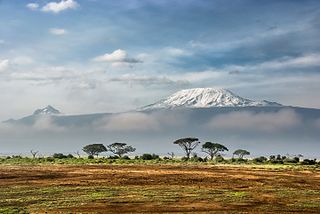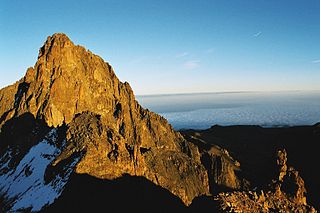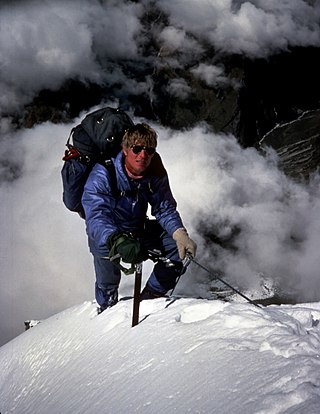Related Research Articles

Mount Kilimanjaro is a massive dormant volcano in Tanzania. It is the highest mountain in Africa and the highest free-standing mountain above sea level in the world, situated at 5,895 m (19,341 ft) above sea level and 4,900 m (16,100 ft) above its plateau base. It is also the highest volcano in the Eastern Hemisphere and the fourth most topographically prominent peak on Earth.

Vinson Massif is a large mountain massif in Antarctica that is 21 km (13 mi) long and 13 km (8 mi) wide and lies within the Sentinel Range of the Ellsworth Mountains. It overlooks the Ronne Ice Shelf near the base of the Antarctic Peninsula. The massif is located about 1,200 kilometres (750 mi) from the South Pole. Vinson Massif was discovered in January 1958 by U.S. Navy aircraft. In 1961, the Vinson Massif was named by the Advisory Committee on Antarctic Names (US-ACAN), after Carl G. Vinson, United States congressman from the state of Georgia, for his support for Antarctic exploration. On November 1, 2006, US-ACAN declared Mount Vinson and Vinson Massif to be separate entities. Vinson Massif lies within the unrecognised Chilean claim under the Antarctic Treaty System.
The Seven Summits are the highest mountains on each of the seven traditional continents. On 30 April 1985, Richard Bass became the first climber to reach the summit of all seven.

Chimborazo is a stratovolcano situated in Ecuador in the Cordillera Occidental range of the Andes. Its last known eruption is believed to have occurred around AD 550. Although not the tallest mountain in the Andes or on Earth relative to sea level, its summit is the farthest point on Earth's surface from the Earth's center due to its location along the planet's equatorial bulge. Chimborazo's height from sea level is 6,263 m (20,548 ft), well below that of Mount Everest at 8,849 m.

Cotopaxi is an active stratovolcano in the Andes Mountains, located near Latacunga city of Cotopaxi Province, about 50 km (31 mi) south of Quito, and 31 km (19 mi) northeast of the city of Latacunga, Ecuador. It is the second highest summit in Ecuador, reaching a height of 5,897 m (19,347 ft). Cotopaxi is among the highest active volcanoes in the world.

Mount Kenya is an extinct volcano in Kenya and the second-highest peak in Africa, after Kilimanjaro. The highest peaks of the mountain are Batian, Nelion and Point Lenana. Mount Kenya is located in the former Eastern and Central provinces of Kenya; its peak is now the intersection of Meru, Embu, Kirinyaga, Nyeri and Tharaka Nithi counties, about 16.5 kilometres south of the equator, around 150 km (90 mi) north-northeast of the capital Nairobi. Mount Kenya is the source of the name of the Republic of Kenya.

Scott Eugene Fischer was an American mountaineer and mountain guide. He was renowned for ascending the world's highest mountains without supplemental oxygen. Fischer and Wally Berg were the first Americans to summit Lhotse, the world's fourth highest peak. Fischer, Charley Mace, and Ed Viesturs summitted K2 without supplemental oxygen. Fischer first climbed Mount Everest in 1994 and later died during the 1996 blizzard on Everest while descending from the peak.

The Illinizas are a pair of volcanic mountains that are located in the north of Latacunga, Cotopaxi, Ecuador. They are located in the Illinizas Ecological Reserve. These twin mountains are separated by a saddle that is about a kilometer long. The peaks are among the highest in Ecuador, with Illiniza Sur standing slightly taller than Illiniza Norte, its northern counterpart, at 5245 metres and 5126 metres respectively.

Cayambe or Volcán Cayambe is a volcano in Ecuador, in the Cordillera Central, a range of the Ecuadorian Andes. It is located in Pichincha Province, some 70 km (43 mi) northeast of Quito. It is the third-highest mountain in Ecuador, at an elevation of 5,790 m (18,996 ft) above sea level.

Sangay is an active stratovolcano in central Ecuador. It exhibits mostly strombolian activity. Geologically, Sangay marks the southern boundary of the Northern Volcanic Zone, and its position straddling two major pieces of crust accounts for its high level of activity. Sangay's approximately 500,000-year-old history is one of instability; two previous versions of the mountain were destroyed in massive flank collapses, evidence of which still litters its surroundings today.

Timothy John Jarvis is an English and Australian explorer, climber, author, environmental activist, and documentary filmmaker. He is best known for his numerous Antarctic expeditions, particularly his attempted Antarctic crossing in 1999 and the period recreations of historical treks by Sir Douglas Mawson and Sir Ernest Shackleton.

Lonnie Thompson, is an American paleoclimatologist and university professor in the School of Earth Sciences at Ohio State University. He has achieved global recognition for his drilling and analysis of ice cores from ice caps and mountain glaciers in the tropical and sub-tropical regions of the world. He and his wife, Ellen Mosley-Thompson, run the ice core paleoclimatology research group at the Byrd Polar Research Center.

The retreat of glaciers since 1850 is a well-documented effect of climate change. The retreat of mountain glaciers provide evidence for the rise in global temperatures since the late 19th century. Examples include mountain glaciers in western North America, Asia, the Alps in central Europe, and tropical and subtropical regions of South America and Africa. Since glacial mass is affected by long-term climatic changes, e.g. precipitation, mean temperature, and cloud cover, glacial mass changes are one of the most sensitive indicators of climate change. The retreat of glaciers is also a major reason for sea level rise. Excluding peripheral glaciers of ice sheets, the total cumulated global glacial losses over the 26 years from 1993 to 2018 were likely 5500 gigatons, or 210 gigatons per year.

Naomi Uemura was a Japanese adventurer who was known particularly for his solo exploits. For example, he was the first person to reach the North Pole solo, the first person to raft the Amazon River solo, and the first person to climb Denali solo.

Hans Heinrich Josef Meyer was a German geographer from Hildburghausen, who was the son of publisher Herrmann Julius Meyer (1826–1909). Hans Meyer is credited with being the first European to reach the summit of Mount Kilimanjaro at 5,895 m (19,341 ft) in modern day Moshi District of Kilimanjaro Region in Tanzania. Kilimanjaro has three peaks: Shira, 3,962 m (12,999 ft); Mawenzi, 5,149 m (16,893 ft); and Kibo, whose summit was reached by Meyer in 1889.

Sergey Anatolyevich Kofanov is a Russian mountaineer.

Glacier hiking involves walking on a glacier with special equipment, such as crampons, rope, climbing harness, helmet and ice axe, so that to some degree it resembles mountaineering.

Mount Tupper 2,804 m (9,199 ft) is a mountain about 37 kilometres (23 mi) west of Golden, British Columbia, Canada and three kilometres east of Rogers Pass in Glacier National Park. Part of the Selkirk Mountains, it was formerly named Hermit Mountain until renamed (1887) in honour of Sir Charles Tupper when he was minister of Railways and Canals in Sir John A. Macdonald's cabinet during the siting and construction of the CPR line through the Selkirk Mountains, and later Prime Minister.

Edita Horrell, previously known as Edita Nichols, is a Lithuanian-born mountaineer and humanitarian aid worker. She became the first Lithuanian woman to reach the summit of Mount Everest, on 22 May 2013.
References
- ↑ Morris, Emma (26 November 2015). "Meet Australia's trailblazing explorers". ABC Radio National. Retrieved 16 September 2017.
- ↑ Mackenzie, Michael (8 December 2017). "Climbing the last equatorial glaciers". ABC Radio National. Retrieved 16 September 2017.
- ↑ Peddie, Clare (3 December 2017). "Explorer Tim Jarvis takes us all on his mountain climbs with 25zero". News.com.au. Retrieved 16 September 2017.
- ↑ "25 Mountains. Zero latitude. 25 years. Zero ice. Press briefing with Tim Jarvis". Scimex. 16 November 2015. Archived from the original on 4 December 2017. Retrieved 16 September 2017.
- ↑ Caddy, Amelia (16 November 2017). "Conquering peaks for climate change". Australian Geographic. Retrieved 16 September 2017.
- 1 2 "Adelaide Film Festival names Jim Bettison and Helen James Award recipients". IF.com.au. 22 September 2016. Retrieved 16 September 2017.
- ↑ "Glaciers on These 25 Mountains Will Completely Melt in 25 Years". EcoWatch. 4 October 2016.
- ↑ Westgarth, Rachael (18 November 2017). "Tim Jarvis appointed as first Idealist for Environmental Understanding". Round Square. Retrieved 16 September 2017.
- ↑ Michael, Mackenzie (23 November 2017). "Climbing for the Climate". ABC Radio National. Retrieved 16 September 2017.
- ↑ Dengate, Cayla (15 July 2017). "Adventurer Tim Jarvis Creates 25Zero To Raise Awareness About Disappearing Equatorial Glaciers". Huffington Post Australia. Retrieved 16 September 2017.
- ↑ Jarvis, Tim (1 October 2016). "25zero Origins". 25zero. Retrieved 16 September 2017.
- ↑ "Kyoto Protocol". United Nations Framework Convention on Climate Change. 2014. Retrieved 16 September 2017.
- 1 2 Jordan, Ekkehard; Hastenrath, Stefan L (18 March 1998). "Glaciers of South America". US Geological Survey. USGS Publications Warehouse.
- ↑ Francou, Bernard; Ramirez, Edson; Cáceres, Bolivar; Mendoza, Javier (2000). "Glacier evolution in the tropical Andes during the last decades of the 20th century: Chacaltaya, Bolivia, and Antizana, Ecuador". Ambio: A Journal of the Human Environment. 29 (7): 416–422. doi:10.1639/0044-7447(2000)029[0416:geitta]2.0.co;2 – via BioOne Complete.
- ↑ "Winners of the 2016 Australian Geographic Society Awards". Australian Geographic. 27 October 2016. Retrieved 16 September 2017.
- ↑ "Tim Jarvis 25zero expedition: background". Australian Geographic. 27 November 2015. Retrieved 16 September 2017.